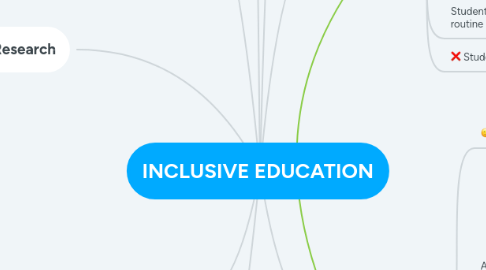INCLUSIVE EDUCATION
by Tamika Magometovs


1. Develops Ethical Leadership
1.1. Leadership can influence
1.1.1. Curriculum
1.1.2. Pedagogy
1.1.3. Assessment
1.1.4. Relationships
1.1.5. Success / Failure
1.1.6. Futures
1.2. Ethics:
1.2.1. a code or set of principles by which people live”
1.2.2. Our relationships with others
1.3. Equality is not the same as equity!
1.4. 3 interrelated ethics:
1.4.1. Ehtic of Care
1.4.2. Ethic of Justice
1.4.3. Ethic of Critique
2. Supporting Laws
2.1. Disability Discrimination Act 1993
2.2. Educational Standards 2005
2.3. UN CRPD General Comment Number 4
3. Supporting Research
3.1. Included students do better academically and socially than those who are segregated
3.2. No study shows segregation superior to inclusion
3.3. Better academically and socially than students who are segregated.
3.4. N no negative impact on the academic progress of other students
3.5. The attitudes and values of other students was better in inclusive classrooms
3.6. No extra time lost to classes through disruptive behaviour
4. What is inclusion?
4.1. Physical Inclusion:
4.1.1. Fully included in the same activities as all other students for the same amount of time. This includes outings, excursions, science experiments etc.
4.2. Social Inclusion:
4.2.1. Socially belonging. A valued member of the class and school like all other students.
4.3. Curricula Inclusion:
4.3.1. Included in the SAME lesson content as other students, with adjustments and adaptations as required
5. What works to build inclusion?
5.1. A change in whole school culture
5.2. No segregation
5.3. Schools adapting
5.4. High expectations for all
5.5. Strong partnerships with families
5.6. Strong collaboration amongst staff
6. Integration
6.1. BAD
6.2. Salamanca Statement (1994) = integration
6.3. Positive in intent
6.4. Focus was on putting students into mainstream classrooms
6.5. Very little change in classroom practices to accommodate students needs
6.6. Resulted in segregation
6.7. Students expected to fit the 'normal' routine
6.8. Students changed to meet schools needs
7. Special Education
7.1. BAD - Views individual as a burden
7.2. Only diagnosed students
7.3. Removed from the classroom into a 'special environment'
7.4. Small number of students diagnosed = little differentiation
7.5. Resulted in segregation
8. Inclusion
8.1. GOOD - Views individual as an asset
8.2. Authentic change called to:
8.2.1. Practice
8.2.2. Pedagogy
8.2.3. Curriculum
8.2.4. Leadership
8.2.5. Community
8.2.6. Values
8.2.7. Ideologies

